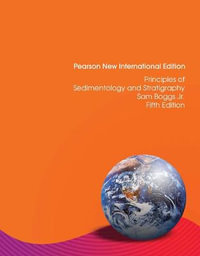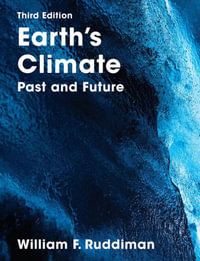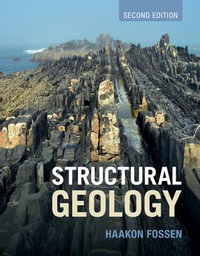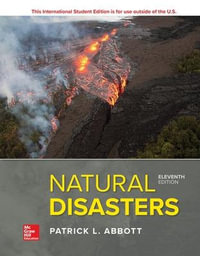
Introduction to Planetary Science : The Geological Perspective
The Geological Perspective
By: Gunter Faure, Teresa M. Mensing
Hardcover | 1 March 2007
At a Glance
548 Pages
25.4 x 17.78 x 3.02
Hardcover
$186.41
or 4 interest-free payments of $46.60 with
orAims to ship in 7 to 10 business days
This textbook is intended to be used in a lecture course for college students majoring in Earth Sciences. Planetary science provides an opportunity for these students to apply a wide range of subject matter pertaining to the Earth to the study of other planets and their principal satellites. In this way, planetary science tends to unify subjects in the Earth Sciences that are traditionally taught separately. Therefore, planetary science is well-suited to be taught as a capstone course for senior undergraduates in geology departments and as an introduction to the solar system in astronomy departments. Both groups of students will benefit because planetary science bridges the gap between geology and astronomy and it prepares geologists and astronomers to participate actively in the on-going exploration of the solar system.
The subject matter is presented in 24 chapters that lead the reader through the solar system starting with historical perspectives on space exploration and the development of the scientific method. The presentations concerning the planets and their satellites emphasize that their origin and subsequent evolution can be explained by applications of certain basic principles of physics, chemistry, and celestial mechanics and that the surface features of the solid bodies in the solar system can be interpreted by means of the principles of geology.
Industry Reviews
From the reviews:
"The authors ... have produced a book that is remarkably up to date, nicely illustrated, and written in an engaging style. An especially effective touch us that each chapter ends with one or more scientific briefs ... . presents an abundance of fascinating information about our cosmic neighborhood, in a form that is readily accessible to students majoring in Earth science. This text will significantly improve teaching and learning about planetary geoscience, and I will be using it for my own undergraduate course ... ."
(Hap McSween, Elements, Vol. 4 (1), 2008)
"This book should be used as the basis for a capstone course for senior undergraduates and beginning graduate students majoring in the Earth sciences. ... The book is fairly well up to date in terms of discoveries ... . Positive points about the book include clear and abundant illustrations and a well-chosen reference list at the end of each chapter. ... well-bound and well-illustrated book. ... is comprehensive and balanced in its coverage of bodies in the solar system."
(David A. Rothery, Eos, Vol. 89 (15), 2008)
"When I was asked to review this textbook, I immediately said yes. I expected that I would enjoy reading the book and that I would undoubtedly learn from it either new facts or methods of presenting facts and their interpretation to students. I was not disappointed; in fact, I was delighted. The book captures the essence of modern planetary science in 24 chapters. The chapters do not overload the reader with an abundance of factual details and their interpreatations but instead present issues at a level that can be clearly understood by majors and nonmajors alike but without compromising the science. The book is clearly excellent - if not outstanding - for use in a course for nonmajors, and I highly recommend it. ... The book is not organized in what I consider to be a classic approach, which is actually a delightful change,and it works very well. In addition, the "science briefs" at the ends of chapters are a wonderful affirmation of each theme. Overall, the book is excellent."
(Harold C. Connolly Jr, The Journal of Geology, Vol. 116, p. 313, 2008)
"Introduction to Planetary Sciences - the Geological Perspective ... is the brain-child of Gunter Faure and Theresa M. Mensing. ... this text not only helps me to acquire new teaching material for my lecture classes, but also exposes me to the latest cosmologic discoveries, told from a geologic point of view. ... . It is the authors' unique ability to intertwine a strong dose of geology, with planetary science, in an easy to understand presentation, that generates the appeal of this book."
(Joseph F. Born Jr., American Association of Petroleum Geologists, Vol. 92 (5), May, 2008)
"A fascinating look at the worlds of our Solar System.
In this excellent textbook, Faure and Mensing succinctly and clearly describe what our Solar System is made of and how it works. Each planet is described in detail-its geology, history, satellites, chemistry, and orbital mechanics. The latest planetary knowledge is presented, and the book is very up-to-date on the latest developments in planetary science, with plenty of new information gleaned from the Hubble Space Telescope and the Cassini Probe. Principles of physics, chemistry, and geology as they pertain to the planets and their celestial mechanics are presented and every chapter is very well-written, clear, and fascinating.
The excellent text is complemented by many brilliant and fascinating pictures in every chapter, including new pictures of the surface of Titan from the Cassini Probe. The high quality of the pictures was a major factor which induced me to buy this book!
I would recommend this as a textbook for a geology class, and for anyone at all who has at least a basic background in science and wants to know more about theother worlds in our solar system and how they operate. It's not a cheap book but it's worth every penny."
(Gordon Trunk, Minneapolis, MN, USA, December 11, 2008)
"This book is a comprehensive review of the current knowledge of planetary sciences. ... The book is best suited for upper division undergraduate students and for beginning graduate students. ... a reference book on planetary sciences that will serve well the shelves of all Earth scientists. ... Due to its holistic and complete approach of the Universe and the Earth's place within the Universe, this book will benefit not only people involved in the planetary sciences but also all those involved in Earth Sciences." (Susana Custodio, Pure and Applied Geophysics, Vol. 166, 2009)
| Preface | p. xvii |
| The Urge to Explore | p. 1 |
| The Exploration of Planet Earth | p. 2 |
| Visionaries and Rocket Scientists | p. 4 |
| Principles of Rocketry and Space Navigation | p. 7 |
| Summary | p. 9 |
| Science Briefs | p. 10 |
| Problems | p. 11 |
| Further Reading | p. 11 |
| From Speculation to Understanding | p. 13 |
| The Geocentric Cosmology of Ancient Greece | p. 13 |
| The Scientific Method | p. 14 |
| Units of Measurement | p. 16 |
| Distance | p. 16 |
| Time | p. 17 |
| Velocity and Speed | p. 17 |
| Mass | p. 18 |
| Temperature | p. 18 |
| Pressure | p. 19 |
| Summary | p. 19 |
| Science Briefs | p. 20 |
| Problems | p. 21 |
| Further Reading | p. 21 |
| The Planets of the Solar System | p. 23 |
| The Sun and the Planets of the Solar System | p. 23 |
| The Titius-Bode Rule | p. 25 |
| Average Orbital Velocities | p. 27 |
| Surface Temperatures | p. 28 |
| Bulk Densities | p. 28 |
| Summary | p. 32 |
| Science Briefs | p. 32 |
| Problems | p. 34 |
| Further Reading | p. 34 |
| Life and Death of Stars | p. 35 |
| The Big Bang | p. 35 |
| Stellar Evolution | p. 39 |
| Nucleosynthesis | p. 41 |
| The Milky Way Galaxy | p. 44 |
| Summary | p. 45 |
| Science Briefs | p. 46 |
| Problems | p. 47 |
| Further Reading | p. 48 |
| Origin of the Solar System | p. 49 |
| The Solar Nebula | p. 49 |
| Origin of the Sun and Planets | p. 50 |
| The Sun | p. 53 |
| Internal Structure | p. 53 |
| Energy Production | p. 56 |
| Magnetism and Sunspots | p. 57 |
| Effect on Space | p. 59 |
| Life and Death of the Sun | p. 59 |
| Summary | p. 61 |
| Science Briefs | p. 62 |
| Problems | p. 62 |
| Further Reading | p. 63 |
| Earth: Model of Planetary Evolution | p. 65 |
| Growth from Planetesimals | p. 65 |
| Internal Differentiation | p. 67 |
| Atmosphere | p. 69 |
| Interior of the Earth | p. 72 |
| Temperature | p. 72 |
| Melting of Peridotite | p. 72 |
| Mantle Plumes | p. 73 |
| Plate Tectonics | p. 74 |
| Magnetic Field | p. 76 |
| Interactions with the Solar Wind | p. 79 |
| Summary | p. 81 |
| Science Briefs | p. 82 |
| Problems | p. 85 |
| Further Reading | p. 85 |
| The Clockwork of the Solar System | p. 87 |
| The Pioneers of Astronomy | p. 87 |
| Elliptical Orbits of Planets | p. 89 |
| Eccentricity | p. 89 |
| Average Distance | p. 90 |
| Revolution and Rotation | p. 90 |
| Plane of the Ecliptic | p. 91 |
| Axial Obliquity | p. 91 |
| Conjunctions and Oppositions | p. 92 |
| Sidereal and Synodic Periods of Revolution | p. 95 |
| Solar and Lunar Eclipses | p. 96 |
| Orbital Velocities | p. 96 |
| Launching Satellites into Orbit | p. 98 |
| Lagrange Points | p. 99 |
| Celestial Mechanics of the Earth | p. 100 |
| Rising and Setting of the Sun | p. 100 |
| Change in the Period of Rotation | p. 101 |
| Seasons of the Northern Hemisphere | p. 101 |
| The Earth at Summer Solstice | p. 101 |
| Autumnal and Vernal Equinoxes | p. 102 |
| Milankovitch Cycles | p. 103 |
| The Gregorian Calendar | p. 104 |
| Summary | p. 105 |
| Science Briefs | p. 105 |
| Problems | p. 107 |
| Further Reading | p. 107 |
| Meteorites and Impact Craters | p. 109 |
| Classification and Mineralogy of Meteorites | p. 110 |
| Carbonaceous Chondrites | p. 112 |
| Tektites | p. 114 |
| Meteorite Parent Bodies | p. 115 |
| Celestial Mechanics | p. 116 |
| Falls and Finds | p. 118 |
| Age Determinations | p. 120 |
| Meteorite Impacts | p. 122 |
| Formation of Craters | p. 122 |
| Classification of Craters | p. 123 |
| Modification of Craters | p. 124 |
| Frequency of Impacts | p. 125 |
| Environmental Consequences (Tunguska, 1908) | p. 126 |
| Meteor Crater: Memorial to E.M. Shoemaker | p. 127 |
| Summary | p. 131 |
| Science Briefs | p. 131 |
| Problems | p. 135 |
| Further Reading | p. 135 |
| The Earth-Moon System | p. 139 |
| Landforms of the Lunar Surface | p. 141 |
| Highlands | p. 141 |
| Maria | p. 142 |
| Impact Craters | p. 143 |
| Regolith | p. 143 |
| Water | p. 143 |
| Isotopic Dating | p. 145 |
| Geology of the Near Side | p. 145 |
| Lunar Meteorites | p. 149 |
| Internal Structure | p. 150 |
| Origin of the Moon | p. 152 |
| Celestial Mechanics | p. 154 |
| Spin-Orbit Coupling | p. 154 |
| Lunar Orbit | p. 155 |
| Tides | p. 156 |
| Ocean Tides | p. 156 |
| Body Tides | p. 157 |
| Research Stations on the Moon | p. 158 |
| Weighing the Risks and Benefits | p. 158 |
| Utilization of Lunar Resources | p. 159 |
| Space Law | p. 160 |
| United Nations: Laws for States | p. 160 |
| NASA: Code of Conduct for Astronauts | p. 161 |
| Summary | p. 162 |
| Science Briefs | p. 163 |
| Problems | p. 166 |
| Further Reading | p. 166 |
| Mercury: Too Hot for Comfort | p. 167 |
| Surface Features | p. 167 |
| Impact Craters and Cliffs | p. 167 |
| Regolith | p. 169 |
| Atmosphere | p. 169 |
| Water | p. 170 |
| Surface Temperatures | p. 170 |
| Internal Structure | p. 171 |
| Iron Core | p. 171 |
| Magnetic Field | p. 172 |
| Geological Activity | p. 173 |
| Origin of Mercury | p. 174 |
| Celestial Mechanics | p. 175 |
| Spin-Orbit Coupling | p. 176 |
| The Solar Transit | p. 177 |
| Rotation of the Long Axis of the Orbit | p. 177 |
| Summary | p. 178 |
| Science Briefs | p. 178 |
| Problems | p. 179 |
| Further Reading | p. 181 |
| Venus; Planetary Evolution Gone Bad | p. 183 |
| Surface Features | p. 184 |
| Geological Processes | p. 187 |
| Volcanic Activity | p. 187 |
| Tectonic Activity | p. 192 |
| Impact Craters | p. 194 |
| Atmosphere and Climate | p. 195 |
| Chemical Composition and Structure | p. 195 |
| Circulation | p. 197 |
| Greenhouse Warming | p. 197 |
| Evolution of the Surface Environment | p. 198 |
| Carbon Cycles of Venus and the Earth | p. 199 |
| Internal Structure | p. 201 |
| The Core and Magnetism | p. 201 |
| Episodic Resurfacing | p. 202 |
| Celestial Mechanics | p. 203 |
| Retrograde Rotation | p. 203 |
| Phases, Conjunctions, and Transits | p. 204 |
| Summary | p. 205 |
| Science Briefs | p. 206 |
| Problems | p. 209 |
| Further Reading | p. 209 |
| Mars: The Little Planet that Could | p. 211 |
| Origin and Properties | p. 213 |
| Origin by Accretion of Planetesimals | p. 213 |
| Physical and Chemical Properties | p. 214 |
| Evolution of the Atmosphere | p. 215 |
| Orbit of Mars | p. 215 |
| Surface Features: Northern Hemisphere | p. 216 |
| Tharsis Plateau | p. 216 |
| Olympus Mons | p. 218 |
| Young Lava Flows | p. 219 |
| Valles Marineris | p. 220 |
| Utopia Planitia | p. 220 |
| Soil of Utopia and Chryse | p. 222 |
| Surface Features: Southern Hemisphere | p. 223 |
| Hellas Impact Basin | p. 224 |
| Argyre Impact Basin | p. 225 |
| Isidis Impact Basin | p. 225 |
| Timescale for Mars | p. 225 |
| Volcanoes of the Southern Hemisphere | p. 227 |
| Syrtis Major Volcano | p. 227 |
| Hespera Planum | p. 227 |
| Hadriaca Patera | p. 228 |
| Stream Valleys | p. 228 |
| Nanedi Vallis | p. 228 |
| Nirgal Vallis | p. 230 |
| Vedra Valles | p. 231 |
| Impact Craters | p. 231 |
| Martian Meteorites | p. 234 |
| Water on Mars | p. 235 |
| Hydrologic Cycle | p. 236 |
| Phase Diagrams of Water and Carbon Dioxide | p. 238 |
| Polar Ice Caps | p. 239 |
| Mountain Glaciers and Continental Ice Sheets | p. 241 |
| Life on Mars | p. 241 |
| Origin and Preservation | p. 241 |
| Search for Life (Vikings) | p. 243 |
| Search for Life (ALH 84001) | p. 243 |
| Search for Life (Rovers) | p. 244 |
| Colonization of Mars | p. 249 |
| Travel to Mars | p. 250 |
| First Steps | p. 251 |
| Terraforming | p. 252 |
| Satellites | p. 252 |
| Summary | p. 253 |
| Science Briefs | p. 254 |
| Problems | p. 258 |
| Further Reading | p. 258 |
| Asteroids: Shattered Worlds | p. 261 |
| Classification | p. 261 |
| Spectral Types | p. 261 |
| Orbits of the Asteroids | p. 262 |
| Physical Properties and Celestial Mechanics | p. 266 |
| First Landings | p. 270 |
| Eros | p. 270 |
| Braille | p. 270 |
| Itokawa | p. 271 |
| Near-Earth Objects (NEOs) | p. 273 |
| Torino Scale | p. 275 |
| Summary | p. 276 |
| Science Briefs | p. 277 |
| Problems | p. 279 |
| Further Reading | p. 279 |
| Jupiter: Heavy-Weight Champion | p. 281 |
| Physical and Orbital Properties | p. 281 |
| Physical Properties | p. 281 |
| Orbital Properties | p. 284 |
| Atmosphere | p. 284 |
| Satellites and Rings | p. 286 |
| Regular Satellites | p. 287 |
| Rings of Jupiter | p. 289 |
| The Spacecraft Galileo | p. 290 |
| Impact of Comet Shoemaker - Levy 9 | p. 291 |
| Summary | p. 292 |
| Science Briefs | p. 293 |
| Problems | p. 295 |
| Further Reading | p. 295 |
| Galilean Satellites: Jewels of the Solar System | p. 297 |
| Physical Properties and Celestial Mechanics | p. 297 |
| Physical Properties | p. 297 |
| Celestial Mechanics | p. 300 |
| Origin: Alternative Hypotheses | p. 303 |
| Io, the Hyperactive Princess | p. 304 |
| Volcanoes | p. 304 |
| Plumes | p. 306 |
| Surface Features | p. 307 |
| Interactions with Jupiter | p. 310 |
| Summary | p. 311 |
| Europa, the Ice Princess | p. 312 |
| Ice Crust and Ocean | p. 314 |
| Impact Craters | p. 316 |
| Chaotic Terrains | p. 318 |
| Life in the Ocean | p. 321 |
| Summary | p. 322 |
| Ganymede in the Middle | p. 323 |
| Ice Crust | p. 323 |
| Rejuvenation | p. 323 |
| A Conjecture | p. 325 |
| Summary | p. 325 |
| Callisto, Left Out in the Cold | p. 326 |
| Physical Properties | p. 327 |
| Impact Craters | p. 328 |
| Differential Sublimation | p. 328 |
| Summary | p. 329 |
| Science Briefs | p. 331 |
| Problems | p. 332 |
| Further Reading | p. 333 |
| Saturn: The Beauty of Rings | p. 335 |
| Physical Properties | p. 335 |
| Atmosphere | p. 335 |
| Internal Structure | p. 337 |
| Celestial Mechanics | p. 338 |
| The Rings | p. 339 |
| The Satellites | p. 341 |
| Ring Satellites | p. 341 |
| Main Group | p. 342 |
| Trans-Titanian Satellites | p. 343 |
| Bulk Densities and Diameters | p. 343 |
| Surface Features of the Regular Satellites | p. 344 |
| Mimas | p. 344 |
| Enceladus | p. 344 |
| Tethys and Dione | p. 346 |
| Ammonia-Water Lava | p. 347 |
| Rhea and Hyperion | p. 349 |
| Iapetus and Phoebe | p. 351 |
| The Cassini-Huygens Mission | p. 352 |
| Summary | p. 353 |
| Science Briefs | p. 354 |
| Problems | p. 356 |
| Further Reading | p. 356 |
| Titan: An Ancient World in Deep Freeze | p. 359 |
| Physical and Orbital Properties | p. 359 |
| Atmosphere | p. 360 |
| Chemical Composition | p. 360 |
| Structure | p. 362 |
| Huygens Lands on Titan | p. 362 |
| Summary | p. 366 |
| Science Briefs | p. 366 |
| Problems | p. 367 |
| Further Reading | p. 367 |
| Uranus: What Happened Here? | p. 369 |
| Physical and Orbital Properties | p. 369 |
| Physical Properties | p. 369 |
| Orbital Properties | p. 370 |
| Atmosphere | p. 372 |
| Internal Structure | p. 373 |
| Rings | p. 373 |
| Satellites | p. 375 |
| Small Satellites | p. 375 |
| Classical Satellites | p. 375 |
| What Happened to Uranus? | p. 380 |
| Summary | p. 381 |
| Science Briefs | p. 382 |
| Problems | p. 383 |
| Further Reading | p. 383 |
| Neptune: More Surprises | p. 385 |
| Surprises Revealed by Voyager 2 | p. 385 |
| Physical and Orbital Properties | p. 387 |
| Atmosphere | p. 387 |
| Internal Structure | p. 388 |
| Rings | p. 390 |
| Satellites | p. 391 |
| Small Satellites | p. 391 |
| Triton | p. 391 |
| Nereid | p. 395 |
| Summary | p. 396 |
| Science Briefs | p. 397 |
| Problems | p. 398 |
| Further Reading | p. 398 |
| Pluto and Charon: The Odd Couple | p. 401 |
| Physical Properties | p. 402 |
| Orbital Properties | p. 403 |
| Summary | p. 405 |
| Science Briefs | p. 405 |
| Problems | p. 407 |
| Further Reading | p. 407 |
| Ice Worlds at the Outer Limit | p. 409 |
| Principals of the Ice Worlds | p. 410 |
| Eris (2003 UB 313) | p. 410 |
| Sedna (2003 VB 12) | p. 412 |
| Quaoar (2002 LM 60) | p. 412 |
| Ixion (2001 KX76) | p. 413 |
| Varuna (2000 WR106) | p. 413 |
| Structure of the E-K Belt | p. 413 |
| The Oort Cloud | p. 415 |
| Summary | p. 416 |
| Science Briefs | p. 417 |
| Problems | p. 418 |
| Further Reading | p. 418 |
| Comets: Coming Inside from the Cold | p. 421 |
| Anatomy of Comets | p. 421 |
| Sources of Comets | p. 423 |
| Short-Period Comets | p. 424 |
| Long-Period Comets | p. 425 |
| Hyakutake | p. 425 |
| Hale-Bopp | p. 426 |
| Meteor Showers and IDPs | p. 428 |
| Close Encounters | p. 430 |
| Giacobini-Zinner in 1985 | p. 430 |
| Halley in 1986 | p. 430 |
| Borelly in 1999 | p. 431 |
| Wild 2 in 2004 | p. 432 |
| Tempel 1 in 2005 | p. 432 |
| Churyumov-Gerasimenko in 2014 | p. 434 |
| Chemical Composition | p. 434 |
| Summary | p. 435 |
| Science Briefs | p. 436 |
| Problems | p. 438 |
| Further Reading | p. 439 |
| Earth: The Cradle of Humans | p. 441 |
| Origin of Life | p. 441 |
| Panspermia | p. 442 |
| Miller-Urey Experiment | p. 442 |
| Mineral Catalysts | p. 443 |
| Cradle of Life | p. 444 |
| Importance of the Biosphere | p. 444 |
| Atmosphere | p. 445 |
| Sedimentary Rocks | p. 445 |
| Fossil Fuels | p. 446 |
| Humans | p. 446 |
| Tales of Doom | p. 448 |
| Evolution of the Sun | p. 448 |
| Impacts | p. 449 |
| Suicide | p. 450 |
| Summary | p. 451 |
| Further Reading | p. 451 |
| Brown-Dwarf Stars and Extrasolar Planets | p. 455 |
| Methods of Discovery | p. 455 |
| Doppler Spectroscopy | p. 455 |
| Occultation | p. 456 |
| Brown-Dwarf Stars | p. 456 |
| Extrasolar Planets | p. 458 |
| Voyage to the Stars | p. 460 |
| Nearby Stars | p. 460 |
| Habitable Planets | p. 461 |
| Voyage to Proxima Centauri | p. 462 |
| SETI and the Drake Equation | p. 463 |
| SETI | p. 464 |
| The Drake Equation | p. 464 |
| Summary | p. 466 |
| Further Reading | p. 467 |
| Mathematical Equations Used in Astronomy | p. 469 |
| Summaries of Physical and Orbital Parameters | p. 475 |
| The Planets and Satellites of the Solar System | p. 475 |
| Orbital Properties of Asteroids | p. 477 |
| Orbital Properties of Selected Comets | p. 478 |
| Glossary | p. 481 |
| Author Index | p. 503 |
| Subject Index | p. 509 |
| Table of Contents provided by Ingram. All Rights Reserved. |
ISBN: 9781402052330
ISBN-10: 1402052332
Published: 1st March 2007
Format: Hardcover
Language: English
Number of Pages: 548
Audience: Adult Education
Publisher: Springer Nature B.V.
Country of Publication: US
Dimensions (cm): 25.4 x 17.78 x 3.02
Weight (kg): 1.16
Shipping
| Standard Shipping | Express Shipping | |
|---|---|---|
| Metro postcodes: | $9.99 | $14.95 |
| Regional postcodes: | $9.99 | $14.95 |
| Rural postcodes: | $9.99 | $14.95 |
How to return your order
At Booktopia, we offer hassle-free returns in accordance with our returns policy. If you wish to return an item, please get in touch with Booktopia Customer Care.
Additional postage charges may be applicable.
Defective items
If there is a problem with any of the items received for your order then the Booktopia Customer Care team is ready to assist you.
For more info please visit our Help Centre.
You Can Find This Book In

Discarded How Technofossils Will be Our Ultimate Legacy
How Technofossils Will Be Our Ultimate Legacy
Hardcover
RRP $42.95
$36.40
OFF
This product is categorised by
- Non-FictionScienceAstronomy, Space & TimeSolar System including The Sun & Planets
- Non-FictionEarth Sciences, Geography, Environment, PlanningEarth SciencesGeology & The Lithosphere
- Non-FictionSciencePhysicsApplied PhysicsGeophysics
- Non-FictionScienceChemistryMineralogy & Gems
- Non-FictionSciencePhysicsApplied PhysicsAstrophysics






















